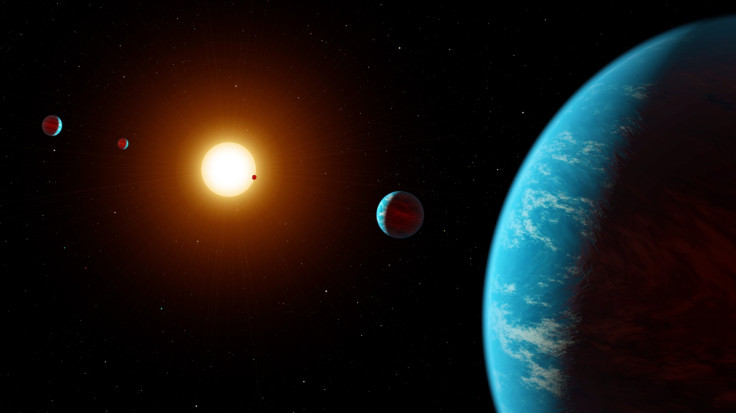Five-Exoplanet System With Super-Earths Discovered By Citizen Scientists Using Kepler Data

Citizen scientists have struck again. Struck proverbial gold, that is. In the first instance of a discovery of this kind through crowdsourcing, five previously unknown exoplanets were identified using data from NASA’s Kepler Space Telescope.
The five planets are all part of the same star system located about 620 light-years from Earth, in the constellation Aquarius. They are all being classified as super-Earths, weighing in at about two to three times larger than our planet. Their orbits around their parent star appear to be concentric circles, unlike the elliptical ones we are familiar with in the solar system. These exoplanets also orbit very close to the star — the longest orbit takes 13 days for one revolution — meaning they are all likely extremely hot.

The system has been named K2-138, after the second phase of the Kepler mission. After a wheel on the spacecraft malfunctioned in 2013, Kepler was reconfigured in 2014 so the telescope continued collecting data from certain parts of the sky for limited periods, and the phase since has been called K2.
All five planets of K2-138 also appear to be in "resonance" — a configuration in which the size of each planet’s orbit is a ratio of other planets’ orbits. That suggests the planets all formed together in a smooth, rotating disc before moving closer in toward the star over millions of years.
The announcement was made Thursday at the ongoing 231st meeting of the American Astronomical Society in Washington, D.C., by researchers from Massachusetts Institute of Technology (MIT) and California Institute of Technology (Caltech). The findings have also been accepted for publication in the Astrophysical Journal.
The project that allowed citizen scientists to make the discovery is called Exoplanet Explorers, and is part of the popular citizen scientist platform Zooniverse. K2 data was made publicly available for the project, and a training program — designed by Caltech’s Jesse Christiansen and MIT’s Ian Crossfield — taught users what they should be looking for.
The K2 data was mostly light curves, showing the intensity of light from individual stars. If there was a dip in the intensity, it could indicate a possible transit across the star’s face by a planet or some other object. Users would look through the data, and indicate for each graph whether they thought the curve looked like a transit or not.
If at least 10 users looked at any particular curve, and at least nine of them (90 percent) indicated a possible transit, Christiansen and Crossfield would analyze that specific signal further. And that is how the five exoplanets of K2-138 were found.
"We put all this data online and said to the public, 'Help us find some planets.' It’s exciting, because we’re getting the public excited about science, and it’s really leveraging the power of the human cloud. … It turns out the world is big enough that there’s a lot of people who are interested in doing some amateur science. And the human eye in many cases is very effective in separating the planetary wheat from the nonplanetary chaff," Crossfield said in a statement Thursday.
While the fact that citizen scientists were the main discoverers of these exoplanets is exciting, and perhaps a harbinger of other similar finds in the future, the discovery itself also has some value for astrophysics.
"Some current theories suggest that planets form by a chaotic scattering of rock and gas and other material in the early stages of the planetary system’s life. However, these theories are unlikely to result in such a closely packed, orderly system as K2-138," Christiansen said in a statement.
The paper, which also mentions the possibility of a sixth exoplanet in K2-138, is titled "The K2-138 system: A Near-Resonant Chain of Five Sub-Neptune Planets Discovered by Citizen Scientists."
© Copyright IBTimes 2024. All rights reserved.











